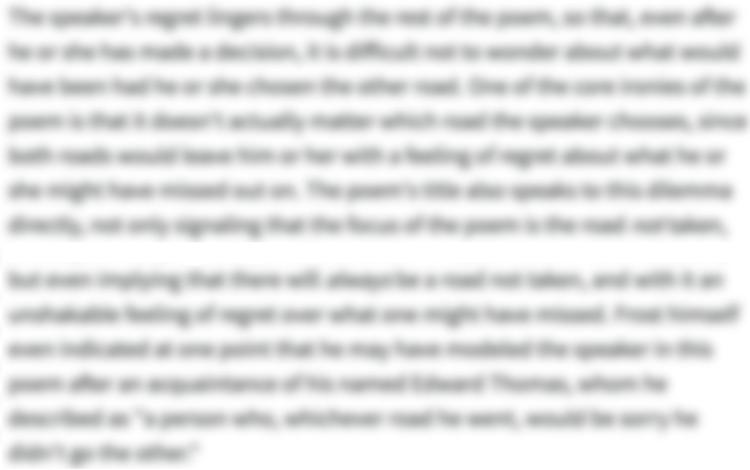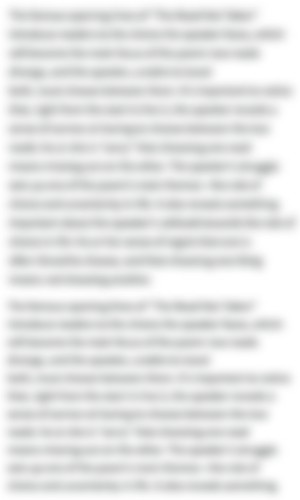-
“The Cold Within” Introduction
-
In James Kinney's 1960s poem "The Cold Within," six men sit around a dwindling fire on a cold night. If the fire goes out, they'll die. Each man has some wood that would keep the fire going, but they all find a reason not to share it: racism, class prejudice, or straight-up selfishness. All the men freeze to death, but it's the metaphorical "cold within"—their unwillingness to be kind to each other—that really kills them. The poem wasn't published in the traditional way, at least at first. Kinney gave "The Cold Within" to his minister, who then passed it on to other ministers; the poem then spread through the wider church community. And it's easy to see why: the poem is essentially a Christian parable showing that self-interest and spite cause misery and death, while values like empathy and charity can save us.
-
-
“The Cold Within” Summary
-
By chance, six men found themselves stuck together in harsh, cold weather. They all had a stick of wood, or so the tale goes.
Their dwindling fire needed more fuel. The first man clung to his stick, having noticed that one of the other men was Black.
The second man looked at the others, and saw someone who practiced a different religion than he did—so he, too, was unwilling to throw his wood in the fire.
The third man was impoverished, his clothes falling apart. He pulled his coat tighter around him, wondering why he ought to throw his log in the fire when one of the others was a lazy, undeserving rich man.
That rich man sat back, dreaming of his riches—and how to keep them away from lazy, unambitious people like the poor man in front of him.
The Black man looked vengeful as the fire died down. He had decided that holding back his stick was a way to get revenge on the white man.
The final man in this doomed group did nothing unless there was something in it for him. He would only give to those who could give him something in return—that was his way of life.
All six men died, still holding on to their firewood. These unused sticks proved that humanity has lost its way. The men died not from the cold around them, but from the cold inside their souls.
-
-
“The Cold Within” Themes
-

Prejudice, Resentment, and Selfishness
In "The Cold Within," six men from different walks of life gather around a dying fire in the freezing cold. They desperately need more wood to keep the fire burning—and thus to keep themselves alive. Luckily, each man holds a stick; unluckily, each man has a reason not to use it. These men would rather hoard their resources—even a mere stick—than help someone they've come to hate. (Or, in the last case, help anyone besides themselves.) Their attitude backfires on them, as all six men end up dying of the cold. Kinney's parable-like poem thus explores the folly of prejudice and resentment, showing how these qualities dehumanize people and, ultimately, lead to tragedy.
The men in the poem, who represent different segments of society, need each other. With the "bitter" cold closing in and their fire at risk of dying, they have an opportunity to heed their better natures, combine their resources, and greatly increase their individual and collective chances of survival. The fire needs logs, and all six men "possess[] a stick of wood." Whatever their ethnicity, economic state, or religious persuasion, they are all, for a moment, equal. They collectively hold everything they need to pull through together.
And yet, as the poem cycles through the men in turn, each one finds somebody in the group to resent. These resentments reflect greater social divides. Two of the men detest each other on racial grounds. The first man holds his stick back because "he notice[s] one was black," while "all" the Black man sees in "his stick of wood" is a "chance to spite the white." In other words, they're locked in a feedback loop of hatred, unable to (re)discover their common humanity. To put it in the poem's terms, they're both suffering from "the cold within."
A rich man and a poor man have a similar problem, according to the speaker. Ironically, each thinks the other is lazy and undeserving of his help—even though offering a stick to the fire would help them individually, too. The rich man smugly recalls his "store" of wealth, though it's totally irrelevant to the men's emergency. Indeed, his selfish, hoarding mentality breeds division. Another man refuses to throw his stick in the fire because the person sitting opposite him is "not of his church." He can't tolerate someone who holds different beliefs.
At their time of greatest need, then, these men suffer their greatest failure of humanity. Their selfishness and prejudice toward one another prevent them from acting empathetically: the fire goes out, and they all die. In this way, their story becomes a fable about the destructive power of hatred. On the face of it, the men die from the physical cold ("the cold without"): that is, they freeze to death. But it's their lack of empathy (the metaphorical "cold within") that really kills them, because it makes them act selfishly and illogically. They'd rather destroy themselves than help each other. This behavior, argues the speaker, is "proof of human sin" (such as greed, wrath, and envy), so it reflects a kind of spiritual as well as physical death.
Though the poem focuses on just six men, their death gestures toward the horrors of the twentieth century (and beyond). The poem works as a parable about, say, the damage of inequality in modern society, or humanity's continuing lust for war.
Where this theme appears in the poem:- Lines 1-32
-

Sin and Salvation
"The Cold Within," which first appeared in a Catholic magazine, tells a Christian-themed parable about humanity's wayward nature. It portrays its six characters as "fallen" (that is, guilty of sin) and holds up their deaths as "proof of human sin." At the same time, it contains an implied prescription for physical and spiritual salvation: charity toward one's fellow human beings. If any of the six had "give[n]" what he had, the poem suggests, the group would have survived. By extension, if humanity bridges its differences and pools its resources, it can stave off its own physical and spiritual destruction.
The poem is a Christian portrait of immorality. The attitudes and actions (or inactions) of the six men align pretty neatly with traditional Christian sins. For example, all six display pride and wrath. They're hellbent on getting back at their fellow men (wrath) and can't see beyond their own stubborn points of view (pride). The rich man might represent greed and gluttony (one of his final thoughts is for his "store" of "wealth"). From the poem's perspective, the poor man in the "tattered clothes" perhaps envies (another sin) the rich man. Both project the sin of sloth (that is, laziness) onto one another. The poem makes the point that "the cold within"—the men's collective spiritual failure—is what kills them. It's their sins, not the weather, that snuff the fire out.
Despite its tragic ending, the poem implies a clear path to spiritual (and, in this case, physical) salvation. All six men refuse to add wood to the fire, so all six die. But if they had acted kindly and selflessly, they would have saved themselves. A charitable attitude would have meant redemption rather than damnation. This redemption, the poem suggests, extends to both body and soul. That is, love and charity can not only keep people warm through the night but redeem them spiritually as well. The poem's parable comments on the wider world, suggesting that traditional Christian values can save humanity from itself. The "cold within" could potentially transform into warmth within, and foster a less destructive world. It's worth noting that Kinney wrote the poem at the height of the Cold War—a time when humanity seemed on the brink of nuclear annihilation.
Where this theme appears in the poem:- Lines 1-32
-
-
Line-by-Line Explanation & Analysis of “The Cold Within”
-
Lines 1-4
Six humans trapped ...
... the story's told.The first stanza sets the poem's scene and establishes its fable-like atmosphere. Six men come together by "happenstance"—that is, by chance. According to the speaker, they're all "trapped" together: an early sign that they're in some kind of danger. The speaker initially calls them "humans," not "men," hinting that the poem is an allegory about human nature in general.
The men are stuck in "bleak and bitter cold" (line 2). The plosive alliteration of "bleak and bitter" evokes the weather's punishing force, while the wintry imagery evokes the spiritual bleakness and emotional bitterness that will carry throughout the poem.
Though the men are in a dire situation, they can still save themselves. They each "possess[] a stick of wood," which, as the next stanza indicates, could keep their fire burning (and keep them all alive). If the solution to their problem sounds simple, well, it's meant to: all they need to do is share their resources. Though the six men are from different walks of life, their circumstances make them all temporarily equal. They're all at risk of death, and they each hold part of what they need to survive as a group.
Line 4 adds a little narrative flourish to the poem: "Or so the story's told." This line makes the story sound like one that has been—and is meant to be—passed around, like a folktale. It might even suggest that the story is worth telling, like a parable: in other words, that it conveys a moral lesson or a broader truth about human nature.
The first stanza also establishes the poem's simple form: quatrains that use common meter (that is, alternating lines of iambic tetrameter and trimeter) and an ABCB rhyme scheme. (For more on these terms, see the Form, Meter, and Rhyme Scheme sections of this guide.) These features make "The Cold Within" an example of a poetic ballad. Ballads usually tell stories, as this poem does, and often contain a moral lesson. Common-meter quatrains are also common in Christian hymns—and this poem, appropriately enough, tells a Christian parable about "human sin." Overall, the form makes the poem and its moral easy to remember.
The opening stanza concludes with an end-stopped line, as all of the following stanzas will also. This effect neatly divides the poem into eight self-contained sections—one for each of the men, plus an intro and conclusion—and subtly reflects the divisions among the men themselves.
-
Lines 5-8
Their dying fire ...
... one was black.

Unlock all 238 words of this analysis of Lines 5-8 of “The Cold Within,” and get the Line-by-Line Analysis for every poem we cover.
Plus so much more...
Get LitCharts A+ -
Lines 9-12
The next man ...
... stick of birch. -
Lines 13-16
The third one ...
... the idle rich? -
Lines 17-20
The rich man ...
... lazy shiftless poor. -
Lines 21-24
The black man's ...
... spite the white. -
Lines 25-28
The last man ...
... played the game. -
Lines 29-32
Their logs held ...
... the cold within.
-
-
“The Cold Within” Symbols
-

The Men
Each man in "The Cold Within" stands for a different group in society and/or a particular prejudice. They're individuals, but they're also meant to represent wider attitudes. All are nameless, making them seem more like universal symbols.
The white man and the Black man, between them, typify the American (or global) racial divide. The rich man and the poor man stand in for economic inequality, and all the hatred and resentment it breeds. The man who "Saw one not of his church" represents religious prejudice, while the man who "Did nought except for gain" represents greed and selfishness more generally.
These attitudes, in turn, map onto some of the main sins in the Christian faith. All the men display the sin of pride, for example, while the rich man displays greed, dreaming "of the wealth he ha[s] in store."
Where this symbol appears in the poem:- Lines 5-28
-

The Fire and the Logs
Fire in this poem symbolizes not only physical but emotional warmth. In order to survive, all the men have to do is throw their sticks in the fire. This would be an act of kindness and charity, an acknowledgment that they're all suffering together. The brighter that fire burns, the greater their display of empathy and understanding. The fire's death, then, represents their collective failure of humanity—the "cold within" their souls.
Notice, too, that the wood in this poem is a collective resource. The men have all they need to survive; similarly, humanity has all that it needs to flourish on this planet. Prejudice and selfishness, however, prevent the fair distribution of resources, both in the poem and in the civilization it criticizes.
Where this symbol appears in the poem:- Lines 1-32
-
-
“The Cold Within” Poetic Devices & Figurative Language
-
Alliteration
The poem's harsh alliteration helps capture its characters' difficult circumstances—and their resentment toward one another.
In the first stanza, for example, the six men are trapped in "bleak and bitter cold" (lines 1-2). These blunt, forceful /b/ sounds are hard on the ear, underscoring how unpleasant the weather is. The poem then deploys some whispery sibilance (lines 3-4):
Each one possessed a stick of wood
Or so the story's told.These /s/ sounds might evoke the whisper and whistle of cold air through the wintry landscape.
The next stanza contains a flurry of fricative /f/s:
Their dying fire in need of logs
The first man held his back
For of the faces round the fire
He noticed one was black.These sounds evoke the flicker and crackle of the fire itself.
Alliteration returns in the sixth stanza, together with some sibilant consonance:
The black man's face bespoke revenge
As the fire passed from his sight.
For all he saw in his stick of wood
Was a chance to spite the white.The /b/ plosives again have a harsh, cacophonous sound that suits the theme of "revenge." The /s/ and /z/ consonance captures both the dying, hissing fire and the man's embittered attitude (the stanza almost sounds like it's hissing with "spite").
In the following stanza, /g/ alliteration links all four lines:
The last man of this forlorn group
Did nought except for gain.
Giving only to those who gave
Was how he played the game.These rough, guttural sounds again reflect the unpleasant sentiments on display. They also highlight the words "gain," "Giving," "gave," and "game," stressing the cynical, transactional nature of the man's worldview. To him, life is just a "game" of acquisition.
Where alliteration appears in the poem:- Line 2: “bleak,” “bitter”
- Line 3: “stick”
- Line 4: “so,” “story's”
- Line 5: “fire”
- Line 6: “first”
- Line 7: “For,” “faces,” “fire”
- Line 21: “black,” “bespoke”
- Line 22: “sight”
- Line 23: “stick”
- Line 24: “spite”
- Line 25: “group”
- Line 26: “gain”
- Line 27: “Giving,” “gave”
- Line 28: “game”
- Line 31: “didn't die”
-
Antithesis


Unlock all 255 words of this analysis of Antithesis in “The Cold Within,” and get the poetic device analyses for every poem we cover.
Plus so much more...
Get LitCharts A+ -
End-Stopped Line
-
Irony
-
Rhetorical Question
-
-
“The Cold Within” Vocabulary
Select any word below to get its definition in the context of the poem. The words are listed in the order in which they appear in the poem.
- Happenstance
- Church
- 'Cross
- Birch
- Tattered
- Hitch
- Idle
- Shiftless
- Bespoke
- Spite
- Forlorn
- Nought except for gain
Happenstance-
(Location in poem: Line 1: “Six humans trapped by happenstance”)
Chance; circumstances.
-
Form, Meter, & Rhyme Scheme of “The Cold Within”
-
Form
"The Cold Within" consists of eight quatrains (four-line stanzas), which use an ABCB rhyme scheme and follow the pattern called common meter (alternating lines of iambic tetrameter and iambic trimeter). Common-meter stanzas are the most traditional type of ballad stanza. For more on this form, see the Meter and Rhyme Scheme sections of this guide.
Ballad stanzas are simple, musical, and memorable. They're often found in folk verse and narrative poetry (such as this poem). Common meter also appears in many church hymns. That echo seems intentional here, as "The Cold Within" was distributed among churchgoers before it was published.
In fact, the poem could be considered a Christian parable in verse form. That is, it's a symbolic story with a Christian lesson at its heart: that "human sin," such as selfishness and hatred, causes destruction and despair. Its clear, unfussy form supports its clear moral message.
The first and last quatrains are like an intro and outro, setting and then commenting on the scene, respectively. In between, the poem cycles through the six men around the fire, like a camera focusing and refocusing on different characters in a film.
-
Meter
"The Cold Within" uses common meter, which consists of alternating iambic tetrameter and trimeter. In other words, it alternates lines of four iambs (feet that run unstressed-stressed: da-DUM) and three iambs. Common meter crops up in numerous church hymns, so it makes a natural vehicle for the poem's Christian message about charity and compassion (and the lack of both in the "sin[ful]" modern world). The simple, propulsive rhythm builds a momentum that carries through to the poem's tragic ending.
However, most of the stanzas feature some metrical variation—or at least can be read as tinkering with the common meter pattern. The fourth stanza, for example, could be read as strict common meter:
The third | one sat | in tat- | tered clothes.
He gave | his coat | a hitch.
Why should | his log | be put | to use
To warm | the id- | le rich?But the third line could also be scanned as "Why should his log [...]" or "Why should his log [...]," either of which would alter the line's tone and emphasis. The looseness of the meter leaves room for the reader to make these kinds of choices. It also reflects the fact that the speaker is a storyteller ("So the story's told"); in other words, it lends the speaker's voice a touch of informality and spontaneity.
-
Rhyme Scheme
"The Cold Within" rhymes every second and fourth line of each stanza, creating a rhyme scheme of ABCB DEFE, etc.
Quatrains with this rhyme scheme are known as ballad stanzas. They lend themselves well to storytelling, which is exactly what's going on in this narrative poem. They're also frequently used in church hymns, so they fit the poem's Christian message.
-
-
“The Cold Within” Speaker
-
"The Cold Within" uses a third-person omniscient narrator—that is, a speaker who describes characters' thoughts as well as their actions. The poem gives little information about its speaker, instead focusing the reader's attention on the six men and their plight.
The first stanza presents the speaker as a storyteller, a voice passing on a tale that has been "told" before:
Six humans trapped by happenstance
In bleak and bitter cold.
Each one possessed a stick of wood
Or so the story's told.This folksy fourth line helps prepare the reader for a fable or parable; it hints that there's a lesson in what the speaker is about to say.
The narration then cycles through the six men in turn, sometimes describing their external appearance (e.g., "The third one sat in tattered clothes") and sometimes reporting their thoughts (e.g., "Why should his log be put to use / To warm the idle rich?").
The speaker also has the final word on the plight of the six men, criticizing their behavior as "proof of human sin." The speaker thus voices a Christian perspective, offering a sermon-like lesson about the danger of selfishness and spite.
-
-
“The Cold Within” Setting
-
"The Cold Within" is set during "bleak and bitter cold" weather—indeed, it's so cold that the six men gathered around the fire are in danger of dying. The poem most likely takes place at nighttime (when a fire's light and warmth would be most needed), though the speaker never says this outright.
The setting establishes a problem for which the characters collectively hold the solution. All six men hold sticks of wood, which, the poem implies, would get them through the cold weather (perhaps till morning)—if only they'd throw their wood in the fire.
Other than the weather and the fire, the poem doesn't expand much on its setting. It's hard to say what century this incident takes place in, let alone which year or what part of the world. The speaker mentions that "the story[]" has been "told" before, so the poem has the atmosphere of a folktale or parable.
It's worth noting that the tensions among the men could easily represent divisions in America (the poet's country) throughout the 20th century and beyond. Keeping the setting general, however, ensures the universal appeal of the poem's message: selfishness and spite destroy humanity, while love and kindness have the power to save us.
-
-
Literary and Historical Context of “The Cold Within”
Literary Context
James Patrick Kinney was a 20th-century American poet, best known for "The Cold Within." He was born in 1923 in Cincinnati, Ohio and dropped out of school in the 10th grade to look after his mother. Kinney had a lifelong interest in poetry and was, for the most part, an autodidact—that is, he taught himself about the art. Kinney's son describes his father as "extremely tolerant," a man who lived in line with the values of the poem.
"The Cold Within" wasn't published via the usual routes. Instead, it was shared by Kinney—a devout Christian—with his church minister in the 1960s, at the height of the Civil Rights Movement. This minister shared it with other churchgoers and ministers, and the poem spread organically due to its parable-like message of charity and community (Kinney was active with a number of charities throughout his life). The poem's unusual passage into wider readership caused some confusion about its author. Indeed, it was often credited to Anonymous—that is, to an unknown writer. Numerous magazines originally rejected the poem due to its then-controversial support of racial equality.
The poem seems inspired by two key forms of literature related to Christianity. First of all, it's a story (as line 4 makes clear). Symbolic stories with clear moral lessons—in this case, the lesson that hatred destroys humanity—are known as parables, and they're a major feature of the Bible (the Gospels in particular). The poem's common meter also borrows the form of many traditional church hymns. These qualities make the poem more memorable and digestible, helping it deliver its message.
Historical Context
"The Cold Within" was written in the 1960s, during the height of the American civil rights movement. Prior to this movement, Black Americans lived as wholly second-class citizens: confined to separate and unequal schools and neighborhoods and often denied the right to vote. During the 1950s and 1960s, Black Americans led a series of legal and political campaigns to reverse these discriminatory laws and to change American ideas about race. The victories they won changed the fabric of American life. The tension between the "black" man and "white" man in the poem gestures toward these larger social struggles.
Class divisions, represented here by the conflict between the "rich" man and the "poor" man, were also rampant in this period (and often overlapped with racial divisions). Needless to say, religious conflict and simple greed—represented by the man who distrusts "one not of his church" and the one who "Did nought except for gain"—have also loomed large in the world's history. As racism, religious prejudice, and economic inequality continue to plague the U.S. and other countries around the world, Kinney's poem has continued to find an audience.
Kinney's inspiration also came on a local level. According to his son, Timothy, Kinney was incensed that state law prohibited Black people from walking on the streets of Cheviot, Ohio after dark. The local council justified the law by claiming that there weren't any Black families living in the area. Kinney and a group of his fellow churchgoers campaigned to change this law. They encouraged a Black family to move to Cheviot, provoking the local council to reverse their position. Kinney was disappointed with the reaction of the surrounding community and shared this poem in response.
-
More “The Cold Within” Resources
-
External Resources
-
More Kinney Poems — Check out more work written by James Patrick Kinney.
-
Kinney's Character — Read an informative interview with the poet's son, Timothy, which talks about Kinney's life and philosophy.
-
Poetry and the Civil Rights Movement — Check out more poems that formed part of the battle for social justice in mid-20th-century America.
-
The Story Behind the Poem — Read about the poem's unusual history, as told by the poet's son.
-
-








